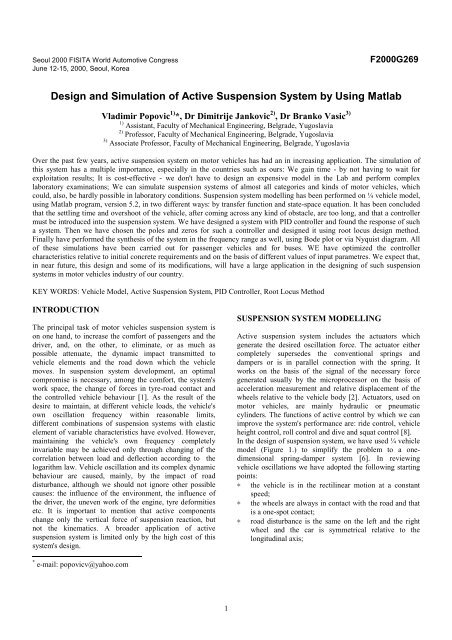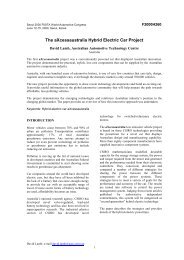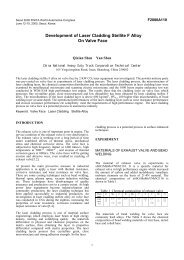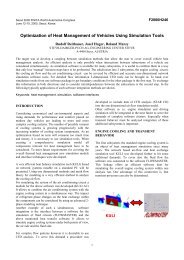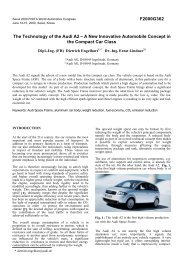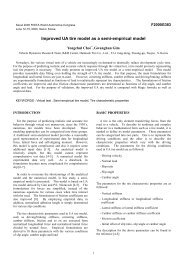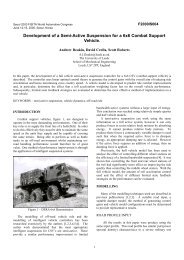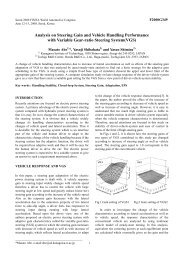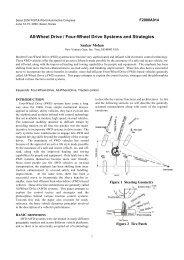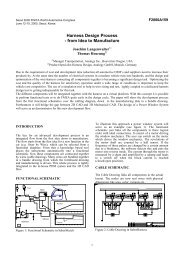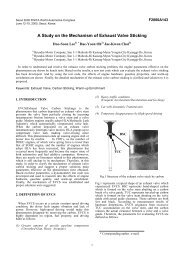Design and Simulation of Active Suspension System by Using Matlab
Design and Simulation of Active Suspension System by Using Matlab
Design and Simulation of Active Suspension System by Using Matlab
You also want an ePaper? Increase the reach of your titles
YUMPU automatically turns print PDFs into web optimized ePapers that Google loves.
Seoul 2000 FISITA World Automotive CongressJune 12-15, 2000, Seoul, KoreaF2000G269<strong>Design</strong> <strong>and</strong> <strong>Simulation</strong> <strong>of</strong> <strong>Active</strong> <strong>Suspension</strong> <strong>System</strong> <strong>by</strong> <strong>Using</strong> <strong>Matlab</strong>Vladimir Popovic 1) *, Dr Dimitrije Jankovic 2) , Dr Branko Vasic 3)1) Assistant, Faculty <strong>of</strong> Mechanical Engineering, Belgrade, Yugoslavia2) Pr<strong>of</strong>essor, Faculty <strong>of</strong> Mechanical Engineering, Belgrade, Yugoslavia3) Associate Pr<strong>of</strong>essor, Faculty <strong>of</strong> Mechanical Engineering, Belgrade, YugoslaviaOver the past few years, active suspension system on motor vehicles has had an in increasing application. The simulation <strong>of</strong>this system has a multiple importance, especially in the countries such as ours: We gain time - <strong>by</strong> not having to wait forexploitation results; It is cost-effective - we don't have to design an expensive model in the Lab <strong>and</strong> perform complexlaboratory examinations; We can simulate suspension systems <strong>of</strong> almost all categories <strong>and</strong> kinds <strong>of</strong> motor vehicles, whichcould, also, be hardly possible in laboratory conditions. <strong>Suspension</strong> system modelling has been performed on ¼ vehicle model,using <strong>Matlab</strong> program, version 5.2, in two different ways: <strong>by</strong> transfer function <strong>and</strong> state-space equation. It has been concludedthat the settling time <strong>and</strong> overshoot <strong>of</strong> the vehicle, after coming across any kind <strong>of</strong> obstacle, are too long, <strong>and</strong> that a controllermust be introduced into the suspension system. We have designed a system with PID controller <strong>and</strong> found the response <strong>of</strong> sucha system. Then we have chosen the poles <strong>and</strong> zeros for such a controller <strong>and</strong> designed it using root locus design method.Finally have performed the synthesis <strong>of</strong> the system in the frequency range as well, using Bode plot or via Nyquist diagram. All<strong>of</strong> these simulations have been carried out for passenger vehicles <strong>and</strong> for buses. WE have optimized the controllercharacteristics relative to initial concrete requirements <strong>and</strong> on the basis <strong>of</strong> different values <strong>of</strong> input parametres. We expect that,in near future, this design <strong>and</strong> some <strong>of</strong> its modifications, will have a large application in the designing <strong>of</strong> such suspensionsystems in motor vehicles industry <strong>of</strong> our country.KEY WORDS: Vehicle Model, <strong>Active</strong> <strong>Suspension</strong> <strong>System</strong>, PID Controller, Root Locus MethodINTRODUCTIONThe principal task <strong>of</strong> motor vehicles suspension system ison one h<strong>and</strong>, to increase the comfort <strong>of</strong> passengers <strong>and</strong> thedriver, <strong>and</strong>, on the other, to eliminate, or as much aspossible attenuate, the dynamic impact transmitted tovehicle elements <strong>and</strong> the road down which the vehiclemoves. In suspension system development, an optimalcompromise is necessary, among the comfort, the system'swork space, the change <strong>of</strong> forces in tyre-road contact <strong>and</strong>the controlled vehicle behaviour [1]. As the result <strong>of</strong> thedesire to maintain, at different vehicle loads, the vehicle'sown oscillation frequency within reasonable limits,different combinations <strong>of</strong> suspension systems with elasticelement <strong>of</strong> variable characteristics have evolved. However,maintaining the vehicle's own frequency completelyinvariable may be achieved only through changing <strong>of</strong> thecorrelation between load <strong>and</strong> deflection according to thelogarithm law. Vehicle oscillation <strong>and</strong> its complex dynamicbehaviour are caused, mainly, <strong>by</strong> the impact <strong>of</strong> roaddisturbance, although we should not ignore other possiblecauses: the influence <strong>of</strong> the environment, the influence <strong>of</strong>the driver, the uneven work <strong>of</strong> the engine, tyre deformitiesetc. It is important to mention that active componentschange only the vertical force <strong>of</strong> suspension reaction, butnot the kinematics. A broader application <strong>of</strong> activesuspension system is limited only <strong>by</strong> the high cost <strong>of</strong> thissystem's design.SUSPENSION SYSTEM MODELLING<strong>Active</strong> suspension system includes the actuators whichgenerate the desired oscillation force. The actuator eithercompletely supersedes the conventional springs <strong>and</strong>dampers or is in parallel connection with the spring. Itworks on the basis <strong>of</strong> the signal <strong>of</strong> the necessary forcegenerated usually <strong>by</strong> the microprocessor on the basis <strong>of</strong>acceleration measurement <strong>and</strong> relative displacement <strong>of</strong> thewheels relative to the vehicle body [2]. Actuators, used onmotor vehicles, are mainly hydraulic or pneumaticcylinders. The functions <strong>of</strong> active control <strong>by</strong> which we canimprove the system's performance are: ride control, vehicleheight control, roll control <strong>and</strong> dive <strong>and</strong> squat control [8].In the design <strong>of</strong> suspension system, we have used ¼ vehiclemodel (Figure 1.) to simplify the problem to a onedimensionalspring-damper system [6]. In reviewingvehicle oscillations we have adopted the following startingpoints:∗ the vehicle is in the rectilinear motion at a constantspeed;∗ the wheels are always in contact with the road <strong>and</strong> thatis a one-spot contact;∗ road disturbance is the same on the left <strong>and</strong> the rightwheel <strong>and</strong> the car is symmetrical relative to thelongitudinal axis;* e-mail: popovicv@yahoo.com1
∗ mass distribution coefficient is approximately 1.Although the real characteristics <strong>of</strong> the suspension system(k1, b1) are non-linear, we have adopted constant values forthem in this paper which, without any significant error,enable the linearization <strong>of</strong> the model. The same has beendone for k2 <strong>and</strong> b2. The designations on Figure 1. have thefollowing meanings:∗ body mass (m1) = 2250 (285) kg;∗ suspension mass (m2) = 290 (60) kg;∗ spring constant <strong>of</strong> suspension system (k1) = 72000(25400) N/m;∗ spring constant <strong>of</strong> wheel <strong>and</strong> tyre (k2) = 450000(200000) N/m;∗ damping constant <strong>of</strong> suspension system (b1) = 315(1300) Ns/m;∗ damping constant <strong>of</strong> wheel <strong>and</strong> tyre (b2) = 13500 (700)Ns/m;∗control force (F a ) = force from the controller we aregoing to design.The data that we used during the simulation are for a bus<strong>and</strong> a passenger car (in the brackets). We have performedsimulations for both categories <strong>of</strong> vehicles (M 3 <strong>and</strong> M 1 -according to ECE Regulations), but have presented hereonly the results obtained for the bus. However, the adoptedconclusions also apply to the passenger car.BodyMass<strong>Suspension</strong>Massk 1Figure 1. - ¼ Vehicle ModelWhen the vehicle is experiencing any road disturbance, thebody should not have large oscillations, <strong>and</strong> the oscillationsshould dissipate quickly. This, at the same time, is ourprincipal task. Since the distance x 1 -W is very difficult tomeasure, <strong>and</strong> the deformation <strong>of</strong> the tyre x 2 -W is negligible,we will use the distance x 1 -x 2 instead <strong>of</strong> x 1 -W as the outputin our problem. The road disturbance W will be simulated<strong>by</strong> a step input. This step could represent the vehiclecoming out <strong>of</strong> a pothole. We want to design a feedbackcontroller so that the output x 1 -x 2 has an overshoot less than5% <strong>and</strong> a settling time shorter than 5 seconds. For example,when the vehicle runs onto a 10 cm high step, the body willoscillate within a range <strong>of</strong> ±5 mm <strong>and</strong> return to a smoothride within 5 seconds.MODELLING BY USING TRANSFER FUNCTIONk 2The assessment <strong>of</strong> the quality <strong>of</strong> automatic regulationsystem behaviour essentially boils down to estimating theerror between a predetermined value <strong>and</strong> the real value <strong>of</strong>the controlled variable. The knowing <strong>of</strong> this error at anypoint would give a complete information on the features <strong>of</strong>the observed system. Due to the diversity <strong>of</strong> the laws <strong>of</strong> theF ab 2b 1X 1X 2Wsystem's input change, which might occur in the normalwork regime, such an approach, based on estimation <strong>of</strong> thecurrent values <strong>of</strong> error, is inappropriate speaking from theaspect <strong>of</strong> practice. Therefore, it is preferable to make anestimation <strong>of</strong> the relevant system characteristics on thebasis <strong>of</strong> the features it manifests at its being disturbed <strong>by</strong>the typical input signals. With such an approach, the systemis being defined both in the stationary <strong>and</strong> transitional workregime. On the basis <strong>of</strong> Figure 1. <strong>and</strong> the Newton's Law, wecan obtain the following dynamic equations, whichrepresent the mathematical model <strong>of</strong> the dynamic system:m 1 x1 = −b1(x1 − x2)− k1(x1− x2)+ Fa(1)m2x2= b1(x1 − x2)+ k1(x1− x2)+ b2(W− x2)+(2)+ k 2(W− x2)− FaThe solving <strong>of</strong> these equations is, to a large extent,simplified <strong>by</strong> the application <strong>of</strong> Laplace transforms. Withthe help <strong>of</strong> these, we can immediately obtain the solutionfor the linear differential equations with constantcoefficients for the given initial conditions. The transformsprovide the representation <strong>of</strong> the system in the form <strong>of</strong> anappropriate block diagram. Although Laplace transformsmay not be the most ideal solution due to the possibility <strong>of</strong>complex algebra occurrence, the majority <strong>of</strong> procedures forthe synthesis <strong>and</strong> analysis <strong>of</strong> the automatic control system,more or less, relies on the application <strong>of</strong> LaplaceTransforms. This approach is not possible with linear nonstationarysystems, in which one or several parametreschange in time [4]. Let's assume that all the initialconditions are zeroes, so these equations represent thesituation when a wheel goes up a bump. The dynamicequations above can be expressed in a form <strong>of</strong> transferfunctions <strong>by</strong> taking Laplace Transform <strong>of</strong> the aboveequations. The derivation from above equations <strong>of</strong> theTransfer functions G 1 (s) <strong>and</strong> G 2 (s) <strong>of</strong> output, x 1 -x 2 , <strong>and</strong> twoinputs, F a <strong>and</strong> W, are as follows:M⎡ 2(m ⎤1s+ b1s+ k1)− (b1s+ k1)⎢⎥ *2⎢⎣− (b1s+ k1)m2s+ (b1+ b2)s+(k1+ k 2)⎥⎦(3)⎡X1(s)⎤ ⎡ Fa(s) ⎤* ⎢ ⎥ = ⎢⎥⎣X2(s)⎦ ⎣(b2s+k 2)W(s)− Fa(s) ⎦2∆ = det[ M]= (m1s+ b1s+ k1) *(4)22* (m2s+ (b1+ b2)s+(k1+ k 2))− (b1s+ k1)Then, we find the inverse <strong>of</strong> the matrix A <strong>and</strong> multiply withinputs F a (s) <strong>and</strong> W(s) on the right h<strong>and</strong> side as thefollowing:⎡m2s2+ 2⎤⎢b 1 b 2 s + (b 1 k 2 + b 2 k 1 )s+k 1 k 2 ⎥⎡X1(s)⎤ 1 ⎢+b 2 s+k 2⎥⎢ ⎥ = **X2(s)⎢m3(m b2 ⎥⎣ ⎦ ∆⎢ 2 1 b 2 s + 1 k 2 + 1 b 2 )s +− m 1 s⎥⎢(b1k2 b2k1)s⎥⎣+ + + k1k2 ⎦⎡F a (s) ⎤* ⎢ ⎥(5)⎣W(s)⎦When we want to consider input F a (s) only, we set W(s)=0.Thus we get the transfer function G 1 (s) as the following:2X1(s)− X 2(s)(m1+ m2)s+ b2s+k 2G 1(s)==(6)Fa(s)∆2
When we want to consider input W(s) only, we set F a (s)=0.Thus we get the transfer function G 2 (s) as the following:3 2X1(s)− X 2(s)− m1b2s− m1k2sG 2(s)==(7)W(s)∆We can put the above Transfer Function equations (6) <strong>and</strong>(7) into <strong>Matlab</strong> <strong>by</strong> defining the numerator <strong>and</strong> denominator<strong>of</strong> Transfer Functions in the form, nump/denp for actuatedforce input <strong>and</strong> nums/dens for disturbance input, <strong>of</strong> thest<strong>and</strong>ard transfer function G 1 (s) <strong>and</strong> G 2 (s):numpnumsG1 (s) = G2(s)=(8)denpdensOn the basis <strong>of</strong> above equations we have created an m-filewith the data that we have found. We can use <strong>Matlab</strong> todisplay how the original open-loop system performs(without any feedback control). Adding the comm<strong>and</strong> 'step(nump,denp)' into the m-file <strong>and</strong> running the file in the<strong>Matlab</strong> comm<strong>and</strong> window, we get the open-loop responseto unit step actuated force.Figure 3. tells us that, when the bus passes a 10 cm highbump on the road, the bus body will oscillate for anunacceptably long time (≈ 50 sec), <strong>and</strong> with a much largeramplitude than the initial impact. The passengers in that buswill not be comfortable with such an oscillation. The bigovershoot <strong>and</strong> the slow settling time will cause damage tothe suspension system. As we have already stated, thesolution to this problem is to add a feedback controller intothe system to improve the performance. We have opted forPID controller, for we have come to the conclusion that noother solution would meet the initial requirements in theright way. The schematic <strong>of</strong> the thus obtained close-loopsystem is the following:r=0 ++ControllerPlantx -x 1 2+ F-aFWFigure 4. Closed-Loop <strong>System</strong> Block DiagramMODELLING BY USING STATE-SPACEEQUATIONFigure 2. Open-Loop Response to Unit Step Actuated ForceFigure 2. tells us that the system is underdumped. Peoplesitting in the bus will feel a small amount <strong>of</strong> oscillation <strong>and</strong>the steady-state error is about 0.01 mm. However, the busneeds unacceptably long time to reach the steady state - thesettling time is rather long. The solution to this problem liesin including a feedback controller into the block diagram <strong>of</strong>the system. Adding the comm<strong>and</strong> 'step(0.1*nums,dens)'into the m-file we get the open-loop response to 0.1 m stepdisturbance.Figure 3. Open-Loop Response to 0.1 m Step DisturbanceThe representation <strong>of</strong> a system in the form <strong>of</strong> the statespaceequation is usually much easier to derive fromdifferential equations than Laplace transform method.Difficulties arise when the derivatives <strong>of</strong> the inputs appearin the differential equations, which leads to a situationrequiring much algebra. The dynamic equations whichinclude the mass both <strong>of</strong> the bus <strong>and</strong> suspension system, arethe same as with modelling <strong>by</strong> using transfer function -equations (1) <strong>and</strong> (2). To be a valid state-spacerepresentation, the derivative <strong>of</strong> all states must be in terms<strong>of</strong> inputs <strong>and</strong> the states themselves. The state variables may,but generally don't have to, be the system output at thesame time. Now, let's choose the states that we shall beusing. To begin, let's divide the equations (1) <strong>and</strong> (2) <strong>by</strong> m 1<strong>and</strong> m 2 , respectively <strong>and</strong> introduce the substitute Y 1 = x 1 -x 2 .Note that W appears in the equation for x 2 :b1k1F ax 1 = − Y1 − Y1+(9)m1m1m1b1k1b2x2= Y1 + Y1+ (W− x2)+m2m2m2(10)k 2Fa+ (W − x2)−m2m2The first state-space equation will be x 1 . Since noderivatives <strong>of</strong> the input appear in the equation for x 1 , wechoose x 1 for the second state. Then, we choose the thirdstate as the difference between x 1 <strong>and</strong> x 2 . After doing somealgebra, we will determine what the fourth state should be.So we subtract equation (10) from equation (9) to get anexpression for Y 1 :3
k k1 1 1 1x1− x2= Y1 = −(+ )Y1 − ( + )Y1−m1m2m1m2(11)b2k 21 1− (W− x2)− (W − x2)+ Fa( + )m2m2m1m2Since we cannot use second derivatives in the state-spacerepresentation, we integrate this equation to get Y1 :b b bY1 1 21 = −(+ )Y1− (W − x2) +m1m2m2(12)k1k1k 21 1+ ∫ ( −(+ )Y1− (W − x2)+ Fa( + ))dtm1m2m2m1m2No derivatives <strong>of</strong> the input appear in this equation, <strong>and</strong> Y 1is expressed in terms <strong>of</strong> states <strong>and</strong> inputs only, except forthe integral. Let's call the integral Y 2 . The state equation forY 2 is:k k k1 1Y (1 1)Y22 = − + 1 − (W − x2)+ Fa( + )m1m2m2m1m(13)2Assuming that x 2 = x 1 -Y 1 <strong>and</strong> substituting the equation (13)into the equation (12) we get state-space for Y 1 :b1b1b2Y 1 = −(+ )Y1− (W − x1+ Y1)+ Y2m1m2m(14)2Then we shall substitute the derivative <strong>of</strong> Y 1 into theequation (9) <strong>of</strong> the derivative <strong>of</strong> x 1 :b1b2b1b1b1b2k1x1= − x1+ ( ( + + ) − )Y1m1m2m1m1m2m2m1(15)b1b2Fab1+ W + − Y2m1m2m1m1The state variables are x 1 , x 1 , Y 1 <strong>and</strong> Y 2. The matrix fromthe above equations (13), (14) <strong>and</strong> (15) is:⎡ 0 100 ⎤⎢ b b b b b b k bx1 201(1 1 2)1 1 ⎥⎡ 1 ⎤ ⎢−+ + − −m m m m m m m m⎥⎢ x⎥ 1 2 1 1 2 2 1 11⎢⎥⎢ ⎥ = ⎢ b2b b bY0 (1 1 2) 1⎥⎢ 1 ⎥− + +⎢ mm m m⎥⎢21 2 2Y⎥ ⎢k 2k k k⎥⎣ 2 ⎦ ⎢ 0 − (1+1+2) 0 ⎥⎢⎣m2m1m2m2⎥⎦⎡ 0 0 ⎤⎢ 1 b bx1 2 ⎥⎡ 1 ⎤ ⎢m m m⎥⎢x⎥ 1 1 21⎢⎥b⎡Fa⎤* ⎢ ⎥ + ⎢02 ⎥(16)⎢Y− ⎢1 ⎥mW⎥⎢⎥2⎣ ⎦⎢ ⎥Y ⎢2 1 1 k⎥⎣ ⎦ ⎢ + −2 ⎥⎢⎣m1m2m2⎥⎦⎡ x1⎤⎢ ⎥⎡ ⎤[ ] ⎢x1 ⎥FaY = 0 0 1 0 + [ 0 0] ⎢Y⎥⎢ ⎥ (17)1 ⎣W⎦⎢ ⎥⎣Y2⎦For the majority <strong>of</strong> problems the state-space method ismuch simpler than the Laplace Transform method. We canput the above state-space equations (16) <strong>and</strong> (17) into<strong>Matlab</strong> <strong>by</strong> defining the four matrices <strong>of</strong> the st<strong>and</strong>ard statespaceequation:X = AX + BW; Y = CX + DW(18)Thus, we have created a new m-file, formed on the basis <strong>of</strong>state-space equation. By adding the comm<strong>and</strong>s'step(A,B,C,D,1)' <strong>and</strong> 'step(A,0.1*B,C,D,2)' <strong>and</strong> running theprogram, we obtain a completely identical situation as inthe Figures 2. <strong>and</strong> 3.DESIGNING PID CONTROLLERThe ultimate goal <strong>of</strong> the system's synthesis lies in thechoice <strong>of</strong> the structure <strong>and</strong> determining the value <strong>of</strong>adjustable system parametres so that the system is providedwith predetermined characteristics in relation to thetransitional <strong>and</strong> stationary work regime. The transferfunction for PID controller is:2K K s K s KKIK sD + P + IP + + D =(19)sswhere K P is the proportional gain, K I an integral gain <strong>and</strong>K D is the derivative gain. We shall be needing all <strong>of</strong> thethree gains for our controller. To start with, <strong>by</strong> iteration wehave come to the following supposition: K P =190000,K I =715000 <strong>and</strong> K D =582000. We enter this into <strong>Matlab</strong> <strong>by</strong>adding the following comm<strong>and</strong> into the m-file:numc=[KD,KP,KI];denc=[1 0].Let's simulate the system's response (the distance betweenX 1 -X 2 ) to unit step road disturbance. From Figure 4. we canfind the transfer function from the road disturbance W tothe output (X 1 -X 2 ):⎡ numf numc⎢ W −⎣ denf denc⎡ numf numc⎢ W −⎣ denf denc( X1−X2)⎤ nump2 ⎥⎦ denp( X − X ) = ( X − X )⎤2 ⎥⎦denpnump( X − X ) = ( X − X )numf ⎛ denp numc⎞W = ⎜ + ⎟( X1− X 2 )denf ⎝ nump denc⎠nump* numf* denc=W denf11( denp* denc+nump* numc)1122(20)As nump=denf, we can simplify the transfer function fromthe equation (20) <strong>and</strong> enter it into the m-file in thefollowing way:numa=conv(numf,denc);dena=polyadd(conv(denp,denc),conv(nump,numc)).Now we have created the close-loop transfer function in<strong>Matlab</strong>, which will represent the plant, road disturbance <strong>and</strong>as well as the controller. Let's see what the close-loop stepresponse for this system looks like before we begin thecontrol process. To simulate 0.1 m high step as ourdisturbance we should multiply 'numa' <strong>by</strong> 0.1. Let's add thefollowing to our m-file:t=0:0.05:5;step(0.1*numa,dena,t).4
time is very short, but that the response does not meet the5% overshoot requirement. We have solved this problemmultiplying K D, K P <strong>and</strong> K I <strong>by</strong> 2. Rerunning this m-file weshould get the following plot:Figure 5. Closed-Loop Response with PID ControllerFrom the graph, the percent overshoot is about 9,5%, whichis 4,5 % larger than the requirement, but the settling time issatisfactory - 3 sec. To choose the proper gain that yieldsreasonable output from the beginning, we start withchoosing a pole <strong>and</strong> two zeros for PID controller. A pole <strong>of</strong>this controller must be at zero <strong>and</strong> one <strong>of</strong> the zeros has to bevery close to the pole at the origin, at 1. The other zero, wewill put further from the first zero, at 3, actually we canadjust the second-zero's position to get the system to fulfillthe requirement. Let's add the following comm<strong>and</strong> in the m-file, so we can adjust the second-zero's location <strong>and</strong> choosethe gain to have a rough idea what gain you should use forK D, K P <strong>and</strong> K I .z1=1; z2=3; p1=0;numc=conv([1 z1],[1 z2]); denc=[1 p1];num2=conv(nump,numc);den2=conv(denp,denc);rlocus(num2,den2);[K,p]=rlocfind(num2,den2)We should see the close-loop poles <strong>and</strong> zeros on the s-planelike this <strong>and</strong> we can choose the gain <strong>and</strong> dominant poles onthe graph <strong>by</strong> ourselves:Figure 7. Closed-Loop Response with PID ControllerNow let's see if the percent overshoot <strong>and</strong> settling timemeet the initial requirements. The overshoot is about 5%,<strong>and</strong> the settling time is approximately 2,5s. For thisproblem, it turns out that the PID design method adequatelycontrols the system. This can be seen <strong>by</strong> looking at the rootlocus plot, for the task can be achieved <strong>by</strong> simply changingonly the gains <strong>of</strong> a PID controller.CONTROLLER DESIGN BY ROOT LOCUSMETHODThe necessary condition for the stability <strong>of</strong> a stationarycontinuous linear system with concentrated parametres isthat all the roots <strong>of</strong> its characteristic equation. have negativereal parts or, which is the same, lie in the left semi-plain <strong>of</strong>the complex s variable. Root locus design <strong>of</strong>fers thepossibility <strong>of</strong> adjusting the poles, zeros <strong>and</strong> transferfunction gain, so that, with closed feedback, the system getsthe desired dynamic characteristics [4]. Let us first see whatare the poles <strong>of</strong> the open-loop automatic control system:R roots(denp)=-23.7792+35.1432i-0.1098+5.2504i-23.7792-35.1432i-0.1098-5.2504iFigure 6. Root Locus with PID ControllerTherefore, the dominant poles are roots -0.1098±5.2504i,which are located close to the complex axis with a smalldamping ratio, <strong>and</strong> which have a dominant influence on theparametres <strong>of</strong> the transitional regime. The main idea <strong>of</strong> rootlocus design is to estimate the response <strong>of</strong> the closed-loopfrom the open-loop locus plot. By adding zeros <strong>and</strong>/or polesto the original system (adding a compensator), the rootlocus <strong>and</strong> thus the closed-loop response will be modified.Let's first view the root locus for the plant.Now that we have the close-loop transfer function,controlling the system is simply a matter <strong>of</strong> changing theK D, K p <strong>and</strong> K I variables. Figure 5. tells us that the settling5
Figure 8. Uncompensated Root LocusAs it was defined earlier, we require the overshoot to beless than 5%. The damping ratio z, can be found from theapproximation damping ratio equation:log( 0.05)z = −(21)2( π2 + log(0.05) )The comm<strong>and</strong> 'sgrid' is used to overlay desired percentovershoot line on the close-up root locus. From the Figure8., we see that there are two pairs <strong>of</strong> the poles <strong>and</strong> zeros thatare very close together. These pairs <strong>of</strong> poles <strong>and</strong> zeros arealmost on the imaginary axis <strong>and</strong> they might make the bussystem marginally stable, which might cause a problem.We have to make all <strong>of</strong> the poles <strong>and</strong> zeros move into theleft-half plane as far as possible to avoid the unstablesystem. We have to put two zeros very close to the twopoles on the imaginary axis <strong>of</strong> uncompensated system forpole-<strong>and</strong>-zero cancellation. Moreover, we put another twopoles further on the real axis to get fast response.ADDING A NOTCH FILTERThe notch filter diminishes the unfavourable dynamics <strong>of</strong>the object. Let's se if the notch filter (two-lead controller)will be sufficient to meet our requirements. We shall put thepoles at 30 <strong>and</strong> 60, <strong>and</strong> zeros at 3±3.5i. To our m-file, weshall add the following comm<strong>and</strong> <strong>and</strong> then run it:z1=3+3.5i; z2=3-3.5i; p1=30; p2=60;numc=conv([1 z1],[1 z2]);denc=conv([1 p1],[1 p2]);rlocus(conv(nump,numc),conv(denp,denc))Now that we have moved the root locus across the 5%damping ratio line, we can choose a gain that will satisfythe design requirements. Recall that we want the settlingtime <strong>and</strong> the overshoot to be as small as possible. Generally,to get a small overshoot <strong>and</strong> a fast response, we need toselect gain corresponding to a point on the root locus nearthe real axis <strong>and</strong> far from the complex axis or the point thatthe root locus crosses the desired damping ratio line. But inthis case, we need the cancellation <strong>of</strong> poles <strong>and</strong> zeros nearthe imaginary axis, so we need to select a gaincorresponding to a point on the root locus near zeros <strong>and</strong>percent overshoot line. We can perform this in <strong>Matlab</strong> inthe following way:[k,poles]=rlocfind(conv(nump,numc),conv(denp,denc))Figure 10. Root Locus with Notch Filterselected point = -2.9559+3.4307ik = 2.2755e+008The value <strong>of</strong> k we use as the gain for the compensator in thefollowing way:numc=k*numc;Now let's see what the closed-loop step response looks likewith the compensator:Figure 11. Closed-loop Response with the Notch FilterFigure 9. Root Locus with Notch FilterFrom this plot we see that when the bus encounters a 0.1mstep on the road, the maximum oscillation amplitude <strong>of</strong> itsbody is about 1.65 mm, <strong>and</strong> the settling time isapproximately 2 sec. This response is satisfactory relativeto the initial requirements.6
FREQUENCY DESIGN METHODSince the phase <strong>and</strong> magnitude curve carry the completeinformation on the dynamic features <strong>of</strong> the system, it is firstnecessary to, in designing the method <strong>by</strong> the applicationfrequency region method, express the technicalrequirements regarding the quality <strong>of</strong> the system's behavior,in the language <strong>of</strong> numerous values <strong>of</strong> the parametres thattypify the appearance <strong>of</strong> these characteristics. This method<strong>of</strong> a great importance also, because the magnitude <strong>and</strong>phase curve can be experimentally recorded without theknowing <strong>of</strong> the analytical expression <strong>of</strong> the transferfunction. The main idea <strong>of</strong> the frequency-based design is touse the Bode plot <strong>of</strong> the open-loop transfer function toestimate the closed-loop response. Adding a controller tothe system changes the open-loop Bode plot so that theclosed-loop response will also change. Let's first draw theBode plot for the original open-loop transfer function.Adding the following comm<strong>and</strong> into the m-file <strong>and</strong>rerunning it we get:w=logspace(-1,2);bode(nump,denp,w)Figure 12. Bode Plot <strong>of</strong> the Open Loop <strong>System</strong>For easier representations <strong>of</strong> systems with naturalfrequencies <strong>of</strong> the system, we normalize <strong>and</strong> scale ourfinding before plotting the Bode plot, so that the lowfrequencyasymptote <strong>of</strong> each term is at 0 dB. Thisnormalization <strong>by</strong> adjusting the gain, K, makes it easier toadd the components <strong>of</strong> the Bode plot. The effect <strong>of</strong> K is themove <strong>of</strong> the magnitude curve up (increasing K) or down(decreasing K) <strong>by</strong> an amount 20 *logK, but the gain, K, hasno effect on the phase curve. Therefore from the previousplot, K must be equal to 100 dB or 100000 to move themagnitude curve up to 0 dB at 0.1 rad/sec. Let's go back toour m-file <strong>and</strong> add the following comm<strong>and</strong> before the 'bode'comm<strong>and</strong> <strong>and</strong> rerun the m-file:nump=100000*numpFigure 13. Bode Plot <strong>of</strong> the Open Loop <strong>System</strong>ADDING TWO-LEAD CONTROLLERFrom the Bode plot above, we see that the phase curve isconcave at about 5 rad/sec. First, we will try to addpositive phase around this region, so that the phase willremain above the -180° line. Since a large phase marginleads to a small overshoot, we will want to add at least 150degrees <strong>of</strong> positive phase at the area near 5 rad/sec. Sinceone lead controller cannot add more than 90 degrees, wewill use a two-lead controller. As we want 150 degrees total,we will need 75 degrees from each controller:1−sin75a = = 0.01733241+sin75Now, let's determine the required space between the zero<strong>and</strong> the pole for the desired maximum <strong>of</strong> the added phase:1T = = 1.51915W aThe value aT is significant because <strong>of</strong> the need to add themaximum phase at the desired frequency:a 0.0173324aT = == 0.02633W 5Now, let's put our two-lead controller into the system <strong>and</strong>see what the Bode plot looks like. We shall add thefollowing comm<strong>and</strong> into the m-file:numc=conv([1.51915 1],[1.51915 1]);denc=conv([0.02633 1],[0.02633 1]);margin(conv(nump,numc),conv(denp,denc))Figure 14. Bode Plot <strong>of</strong> the <strong>System</strong> with Notch Filter7
From this plot we see that the concave portion <strong>of</strong> the phaseplot is above -180° now, <strong>and</strong> the phase margin is largeenough for the design criteria. Let's see how the output (thedistance X 1 -X 2 ) responds to a bump on the road (W).actuator <strong>of</strong> excellent performance), so our next step ismodelling with an all-digital control system.This model is the result <strong>of</strong> a joint venture with the Yugoslavbus <strong>and</strong> passenger car industry, <strong>and</strong> it is the first step indesigning such systems in our country. We hope that, infuture, this cooperation will result in the practicalrealization <strong>of</strong> this project.REFERENCESFigure 15. Closed-loop ResponseThe amplitude <strong>of</strong> response is a lot smaller than the 5 %overshoot requirement (approximately 1.5 mm), <strong>and</strong> thesettling time is less than 5 sec. We can see that anamplitude <strong>of</strong> the output's response is less than 0.0001 m or1% <strong>of</strong> input magnitude after 3 sec. Therefore we can saythat the settling time is 3 sec from the above plot. From theBode plot above, we see that increasing the gain willincrease the crossover frequency <strong>and</strong> thus make theresponse faster. This response is now satisfactory <strong>and</strong> nomore design iteration is needed.[1] Janicijevic, N., Jankovic, D., Todorovic, J., " MotorVehicles <strong>Design</strong>", The Faculty <strong>of</strong> Mechanical Engineering,Belgrade, 1998.[2] Janicijevic, N., "Automatic Control in Motor Vehicles",The Faculty <strong>of</strong> Mechanical Engineering, Belgrade, 1993.[3] Lujan, M. L., "Passive <strong>and</strong> Sky-Hook Damping <strong>Active</strong><strong>Suspension</strong> Half-Car Models with Tire Lift-Off", TechnicalReport, Berkeley University <strong>of</strong> California, USA, 1998.[4] Stojic, M., "Automatic Control <strong>System</strong>s", The Faculty<strong>of</strong> Transportation, Belgrade, 1999.[5] Popovic, V., "<strong>Active</strong>, Semi-<strong>Active</strong> <strong>and</strong> Passive<strong>Suspension</strong> <strong>and</strong> its Functions", Seminar paper, The Faculty<strong>of</strong> Mechanical Engineering, Belgrade, 1998.[6] Popovic, V., "Bus <strong>Active</strong> <strong>Suspension</strong> Modelling <strong>Using</strong><strong>Matlab</strong> 5.2", Yugoslav Operational Research Symposium'99, Belgrade, 1999.[7] Calasan, L., Petkovska, M., "<strong>Matlab</strong> <strong>and</strong> AdditionalModules", Micro-book, Belgrade, 1996.[8] Gillespie, T. D., "Fundamentals <strong>of</strong> Vehicle Dynamics",Society <strong>of</strong> Automotive Engineers, Inc, Warrendale, 1992.CONCLUSIONThe benefits <strong>of</strong> this kind <strong>of</strong> modelling <strong>and</strong> simulation havealready been pointed out in the abstract. Practice <strong>and</strong>literature tell us that this model is representative for thesuspension system <strong>of</strong> vehicles, which is confirmed <strong>by</strong> thefact that similar models are used on many universities <strong>and</strong>institutes throughout the world. It is <strong>of</strong> great importancethat we can perform modelling in two different ways <strong>and</strong>yet get identical results. We have presented severaldifferent methods for obtaining controller gain, butdepending on the concrete situation we opt for one <strong>of</strong> them.Also, we find that the situation when a vehicle runs into abump, is better for suspension system dimensioning ascompared to the situation when the road is considered to bea cluster <strong>of</strong> sinus waves. This is due to the fact that the firstsituation requires a much faster <strong>and</strong> more precise systemresponse. Maybe the greatest <strong>of</strong> the advantages <strong>of</strong> such amodel is its applicability to any category <strong>of</strong> motor vehicleswith active suspension system.During the application <strong>of</strong> methods, techniques <strong>and</strong>procedures <strong>of</strong> the linear automatic control system, oneshould bear in mind that the obtained results exclusivelyrefer to the model <strong>and</strong> not the real system. Therefore, thesystem performance achieved on the basis <strong>of</strong> the model, isonly an approximate performance <strong>of</strong> the real system in thework range which is being observed. Moreover, we havenoticed a rather large frequency at the controller output (<strong>by</strong>the term controller we also imply the compensator <strong>and</strong>8


